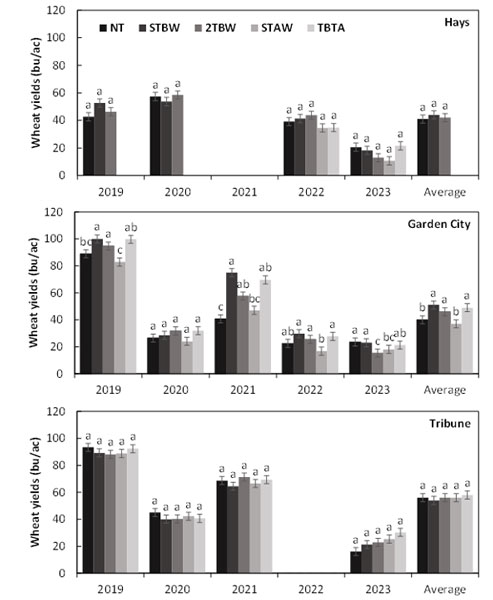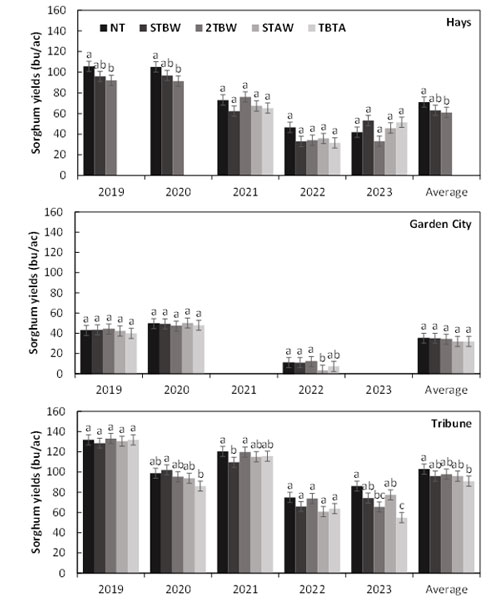No-tillage (NT) farming has been widely adopted across Kansas and the High Plains to enhance soil water storage efficiency, increase grain yields, and reduce soil erosion. However, with an increasing abundance of difficult-to-control and herbicide-resistant (HR) weeds invading long-term NT crop fields and increasing observations of pH, phosphorus, and soil organic carbon stratification, some producers consider tillage a cost-effective way of controlling weeds. The lack of effective herbicide options to control HR kochia (Kochia scoparia L.) and Palmer amaranth (Amaranthus palmeri S. Watson) as well as perennial grass weeds like tumble windmillgrass (Chloris verticillata Nutt.), tumblegrass (Schedonnardus paniculatus), and purple three-awn (Aristida purpurea Nutt.) poses some of the greatest challenges in NT systems. Since 2013, researchers at the Kansas State University Western Kansas Research-Extension Centers have studied occasional tillage in NT fields to manage difficult-to-control and HR weeds and evaluated impacts on crop yields and soil properties near Hays, Garden City, and Tribune, KS.
What is occasional tillage?
Tillage systems can differ in frequency and equipment used, ranging from the most intensive conventional tillage using moldboard plows, chisels, or disks to less frequent occasional tillage or conservation tillage using sweep plows. Occasional tillage is defined as one or two tillage operations every three or more years to manage challenges of long-term NT, including difficult-to-control weeds as well as soil nutrient and pH stratification. This system of low-frequency tillage on a fixed schedule differs from strategic tillage, which is defined as a one-time tillage operation in an otherwise NT cropping system. By these definitions, occasional tillage may be considered a proactive approach while strategic tillage may be considered more reactive. The most commonly used implement for occasional tillage is the sweep plow, which is a non-inversion conservation tillage implement. Inversion-type tillage with a disk may be preferable in correcting soil nutrient and pH stratification if needed.
Impacts of occasional tillage
Kansas State University researchers investigated the effects of occasional tillage on soil properties and crop yields in a winter wheat-grain sorghum-fallow cropping system across three sites near Hays, Garden City, and Tribune, KS. The studies at Garden City and Tribune were originally initiated in 2013, followed by Hays in 2014, with treatments updated in 2016/2017.
The current experiment included five tillage treatments:
- continuous NT
- a single tillage pass during fallow before wheat planting (STBW)
- two tillage passes in fallow before wheat planting (2TBW)
- a single tillage pass after wheat harvest (STAW)
- a single tillage pass before wheat planting and a single tillage pass after wheat harvest (TBTA).
Tillage operations were implemented using a sweep plow equipped with pickers for effective weed control with minimal residue disturbance.
Results: Soil properties
Results showed that soil pH, organic carbon (SOC), and phosphorus content were unaffected by tillage treatments (Table 1). However, soil nitrate content was 1.4-fold greater with 2TBW compared to STBW or NT. Soil bulk density (BD), water-stable aggregates (MWD), and wind-erodible fraction (WEF) were also unaffected by tillage treatments (Table 1). However, soil penetration resistance (PR) was 11% less with STBW or 2TBW than NT.
Table 1. Occasional tillage effects on soil chemical and physical properties.
|
Treatments |
pH |
SOC (%) |
NO3 (ppm) |
P (ppm) |
|
No-tillage |
6.4a† |
1.27a |
15.2b |
77.9a |
|
1 pass before wheat |
6.5a |
1.22a |
16.6b |
77.5a |
|
2 pass before wheat |
6.5a |
1.25a |
22.6a |
71.2a |
|
|
|
|
||
|
Treatments |
BD (g/cm3) |
MWD (mm) |
WEF (%) |
PR (MPa) |
|
No-tillage |
1.32a |
0.53a |
27.6a |
1.26a |
|
1 pass before wheat |
1.30a |
0.46a |
25.5a |
1.13b |
|
2 pass before wheat |
1.30a |
0.47a |
25.5a |
1.11b |
†Means followed by the same lower-case letter within the same column are not significantly different (α = 0.05) among treatments.
Results: Wheat and sorghum yields
Wheat yields were not different across tillage treatments in any year at Hays or Tribune (Figure 1). However, wheat yield varied across treatments at Garden City in some years. Generally, wheat yields were in the order of STBW > TBTA > 2TBW > NT > STAW. Grain sorghum yields at Hays were in the order of NT > STBW > 2TBW in 2019 and 2020 (Figure 2), but were unaffected by tillage in other years. At Garden City, grain sorghum yields were unaffected by tillage in 2019 or 2020. However, yields at Garden City were less with STAW than NT, STBW, and 2TBW. At Tribune, grain sorghum yields were unaffected by tillage in 2019 or 2022. In 2020, sorghum yields were greatest with STBW and least with TBTA. However, in 2021, sorghum yields were greatest with NT and 2TBW and least with STBW. Similarly, in 2023, sorghum yields at tribune were greatest with NT followed by STBW, STAW, and 2TBW and least with TBTA.

Figure 1. Occasional tillage† effects on subsequent winter wheat yields at Hays, Garden City, and Tribune, KS from 2019 to 2023.
†NT, no-tillage; STBW, one pass before wheat; 2TBW, two pass before wheat; STAW, one pass after wheat; TBTA, one pass before wheat followed by one pass after wheat.

Figure 2. Occasional tillage† effects on grain sorghum yields at Hays, Garden City, and Tribune, KS from 2019 to 2023.
†NT, no-tillage; STBW, one pass before wheat; 2TBW, two pass before wheat; STAW, one pass after wheat; TBTA, one pass before wheat followed by one pass after wheat.
Summary
Overall, occasional tillage had no negative effects on soil properties but decreased soil penetration resistance. Tillage effects on subsequent wheat yields were infrequent, but results at Garden City suggest yields might be greater with STBW compared to NT. However, grain sorghum yields were occasionally reduced with 2TBW or TBTA at Hays and Tribune. Occasional tillage could be an effective tool for farmers to manage difficult-to-control and HR weeds. However, farmers should be mindful of best management practices when implementing occasional tillage:
- Occasional tillage with a sweep plow should be timed when soil erosion risk is lowest. In western Kansas, the best time is in summer fallow before winter wheat planting.
- Timing is critical to ensure successful control of perennial grass weeds. Tillage should be implemented with a sweep plow equipped with pickers, operated at shallow depth, on a hot, dry day with no chances for rain for several days following tillage.
- The tillage depth should be kept shallow (1-2 inches) to control perennial grass weeds (most are shallow-rooted) and prevent the burying of crop residue. Deeper tillage may only spread and bury rhizomatous weeds like field bindweed or johnsongrass, increasing management challenges.
- The frequency of occasional tillage will depend on the crop rotation as well as the time it takes for issues to resurge after returning to NT management.
For more detailed information on this study, please refer to:
- “Occasional Tillage in a Wheat-Sorghum-Fallow Rotation” in the 2021 Kansas Agricultural Experiment Station Research Reports: Vol. 7: Iss. 7. https://newprairiepress.org/kaesrr/vol7/iss7/1/
- “Occasional Tillage in a Wheat-Sorghum-Fallow Rotation: 2022 Growing Season” in the 2023 Kansas Agricultural Experiment Station Research Reports: Vol. 9: Iss.6. https://newprairiepress.org/kaesrr/vol9/iss6/4/
Logan Simon, Area Agronomist, Southwest Research-Extension Center
lsimon@ksu.edu
Augustine Obour, Soil Scientist, Agricultural Research Center - Hays
abour@ksu.edu
John Holman, Cropping Systems Agronomist, Southwest Research-Extension Center
jholman@ksu.edu
Lucas Haag, Area Agronomist, Northwest Research-Extension Center
lhaag@ksu.edu